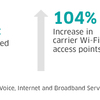Large enterprises increasingly resemble public network service providers as they manage access, transport and network routing while controlling devices and sessions. Whether businesses build their own or buy their communications services through a public provider, the IP communications architectures are looking remarkably similar.
“I’ve noticed that both private service operators (CIOs of large enterprises) and public service providers are implementing very similar solutions around the globe,” wrote Oliver Krahn in a recent TechZine article, 6 Steps that Improve Communications Services.Link for graphic.
He has noticed that successful service providers are all more or less taking the following six steps when it comes to building their IP communications architecture. Firms building out their communications services would be wise to pay attention.
First, firms are moving to an IP communications architecture to enable a whole new conversation experience. With so many communications options, the value of having a unified inbox that collects all of these communications services is invaluable to users. And this means moving to all-IP.
Second, APIs are being used to expose network-based IP communications applications.
“This lets them share innovation opportunities with partners while developing carrier-grade and real-time web-communications strategies that keep them current on new modes of communications,” noted Krahn. “Beyond this, more visionary CIOs are exploring next-generation IP communications architectures that may replace today’s PSTN.”
Third, content strategies are being adjusted to take advantage of on-net content delivery networks at the network edge and transparent caching to handle the volume of video data now being moved across the network.
Fourth, they are using small cell networks to avoid bottlenecks and access gaps.
“By deploying multi-standard, small-cell base stations, a large enterprise can achieve cost-effective 3G, 4G and Wi-Fi connectivity,” noted Krahn. “It can then be handed over to a trusted mobile provider to light them up with licensed spectrum. In-building coverage for any size venue and any number of users is also part of the mix; so is reducing the cost of delivering ultra-broadband access in a multi-operator deployment with low-cost digital distributed antenna systems.”
Converged virtual private networks also are being employed to deliver a seamless experience to enterprise users. Enterprise service gateways (ESGs) offer a seamless experience to enterprise users independent of the access bearer and the device. They deliver scalability, high performance and carrier-grade resiliency for VPN services.
This combination of capabilities allows the ESG to concurrently replace the mobile gateway (PGW, GGSN), PE router and border gateway, simplifying the network.
Finally, Krahn has noticed that successful solutions are leveraging cloud-based applications and network functions virtualization (NFV).
“Private and public service providers are realizing that the future of telecommunications networks will be based on virtualizing key network functions,” he noted. “These cloud platform components ease service deployment, automate management and clear the path to cost-effective growth. At the same time, NFV-ready applications, an advanced NFV platform and an NFV partner ecosystem are crucial for achieving the goals of cloud-based applications.”
As noted, Alcatel-Lucent has a white paper, Six Steps to Attractive Communications Services, that fully outlines these six steps used by successful communication service providers, whether enterprises or public providers.











